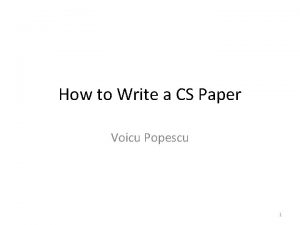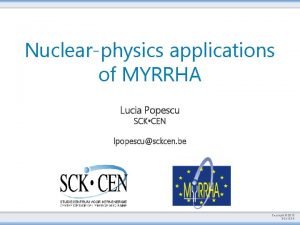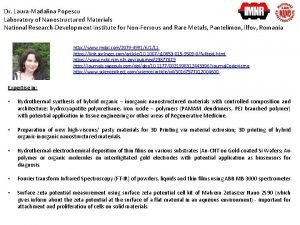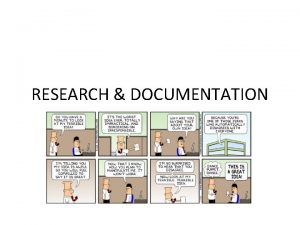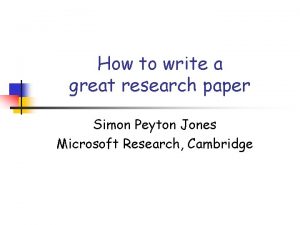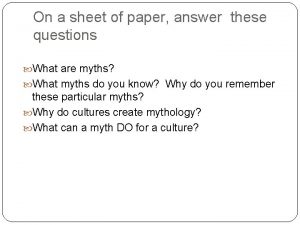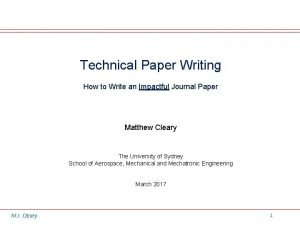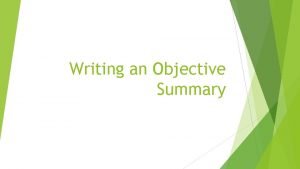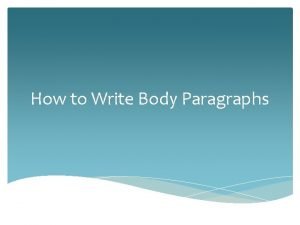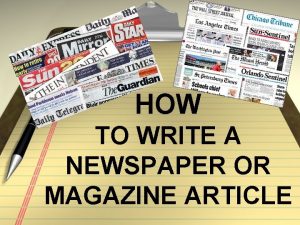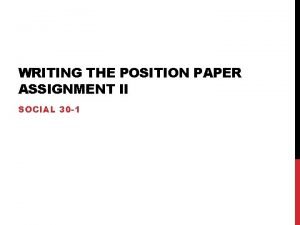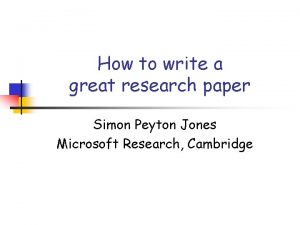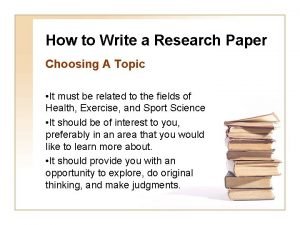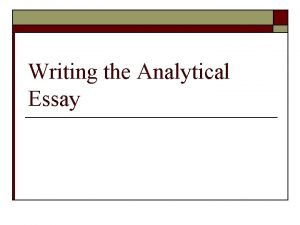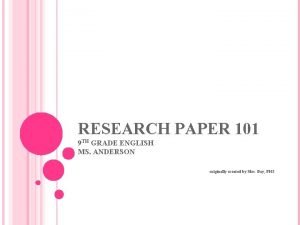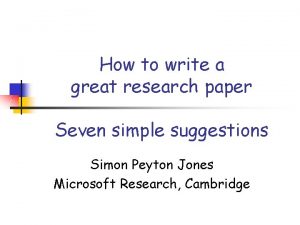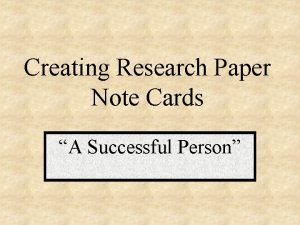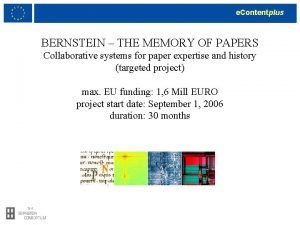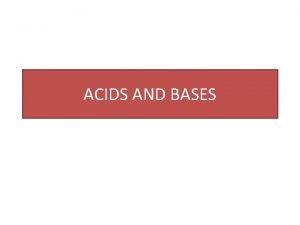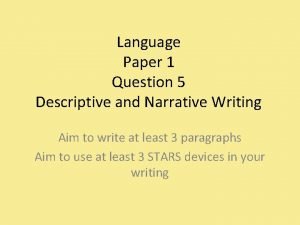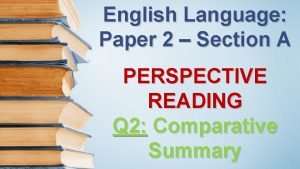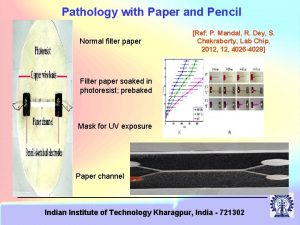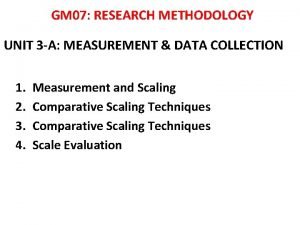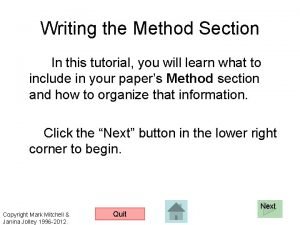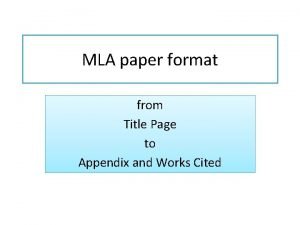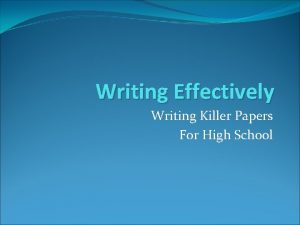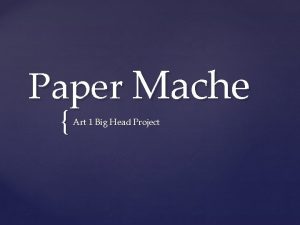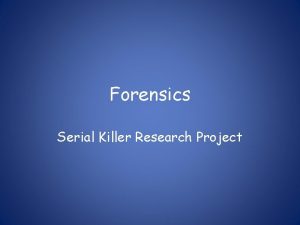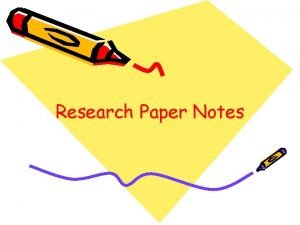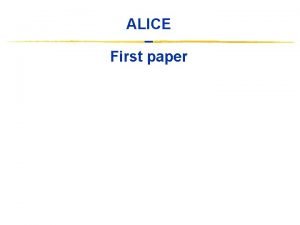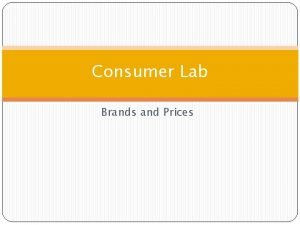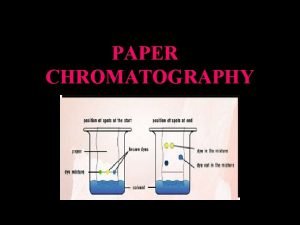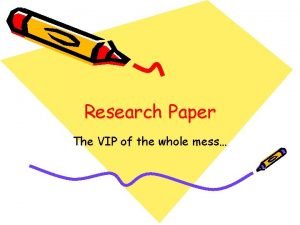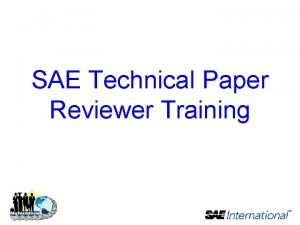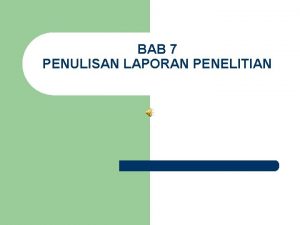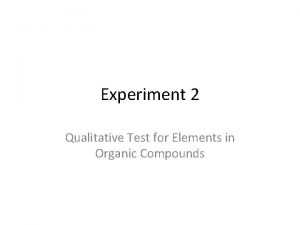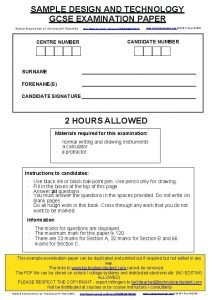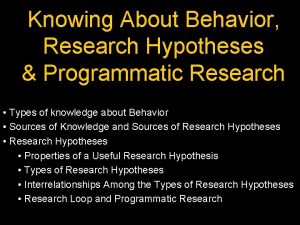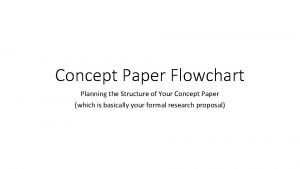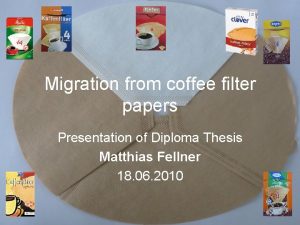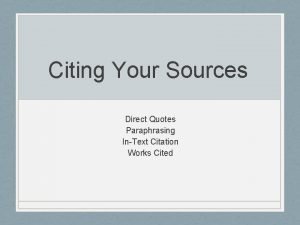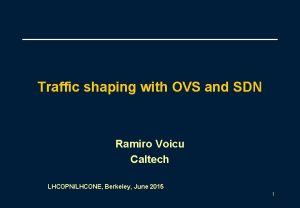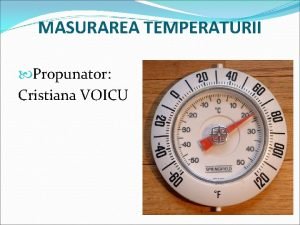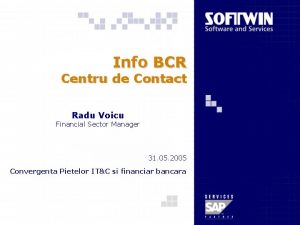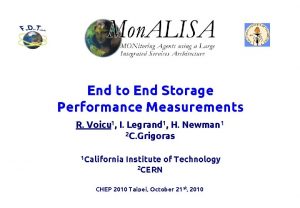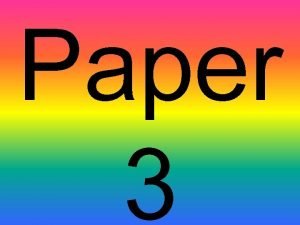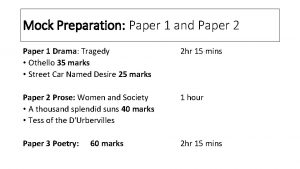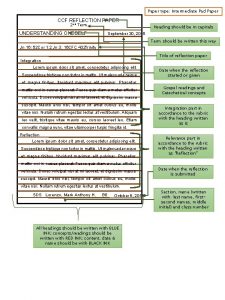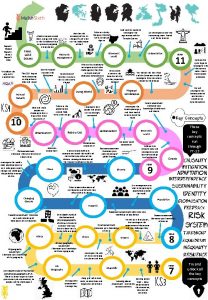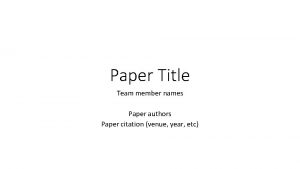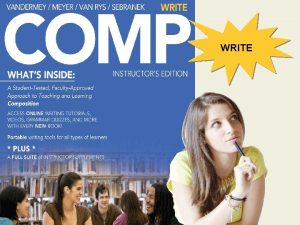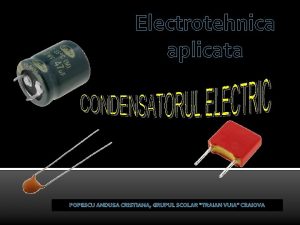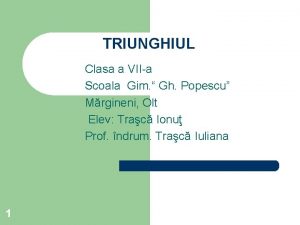How to Write a CS Paper Voicu Popescu































































- Slides: 63

How to Write a CS Paper Voicu Popescu 1

Overview • A lecture on how to write CS research papers • A systematic approach—a recipe, a formula, an algorithm 2

Motivation • Writing a paper is difficult – Complex topic – New results • Paper writing rarely taught explicitly in graduate school – Learned by reading papers – Learned through painful trial and error 3

Misconceptions about paper writing • “Writing a paper takes a couple of hours” – No. It takes an experienced writer a week w/ sleep and 36 h w/o sleep to write a paper. • “Writing a paper takes literary talent” – No. Keep poetry and metaphors out of the paper. • “Writing a paper is a mysterious, amorphous process” – No. There is a method for writing papers. • “English proofreading services can fix a poorly written paper” – No. English proofreading fixes language problems, not exposition problems. 4

When to start writing • Option 1: once you have proof of concept – Pro: plenty of time available for writing – Con: not all results available, writing has to anticipate results, writing cannot accurately emphasize strengths demonstrated in results – Recommended for conference submissions, and for novice writers – Might require a second writing pass (i. e. a major revision) to fine tune paper to final results 5

When to start writing • Option 2: once all results are obtained – Pro: writing reflects results with high fidelity, including in abstract and in introduction – Con: little time available for writing, due to imminent (conference) deadline – Recommended for conference submissions for experienced writers, and for journal submissions (no hard deadline) – Warning: can lead to submission delays 6

Formatting • Use template provided by targeted venue – Word – La. Tex • Format from the beginning – Accurate estimate of paper length – Avoids formatting nightmares close to the deadline 7

Tell a story • A well written paper tells a story • The story has to – flow from the “introduction” section all the way to the “conclusions and future work” section – be easy to read – be exciting – clearly state contributions – not overstate contributions – provide sufficient detail for reproducibility – not follow the work timeline proportionally 8

Tell a story • The story has to – reiterate important points (title, abstract, introduction, method, and conclusions) without being repetitive – be consistent, no contradictions – contain no ambiguities; no “would”, “could”, “should”, “might”; everything described outside the future work section should have been actually implemented; no speculations 9

Figures • Whenever something is hard to describe, use a figure (i. e. diagram, image, graph) • Have enough figures, with detailed captions – Someone looking only at figures should get the main idea of the paper • Figures should be of very high quality – Use professional software, e. g. Visio – Be prepared to invest time (multiple hours, revisions) – Start with canvas of final size – 8 pt font in the final paper layout (no scaling) 10

Philosophy • Your method is assumed to be bad until you prove that it is good • Your paper is assumed to be rejected until you prove it has to be accepted • It is not enough to not provide good reasons for the paper to be rejected • You have to provide good reasons for the paper to be accepted 11

Paper components • • • Title Authors list Abstract Keywords Introduction Prior work Method overview Method details 1 Method details 2 … • Results and discussion • Conclusions and future work • Acknowledgments • References • Appendices • Video 12

Title • Important – First thing a reader sees – Together with abstract and keywords used to decide reviewers • Desired qualities – – Informative Accurate Not too long Catchy, easy to remember, impressive • Formatting – Capitalize every word except for prepositions – “Reflected-Scene Impostors for Realistic Reflections at Interactive Rates” 13

Title architecture • Most frequently – Nickname: New-Thing for What • “The Warp. Engine: An Architecture for the Post-Polygonal Age” • “GEARS: A General and Efficient Algorithm for Rendering Shadows” – New-Thing for What • “Simplification of Node Position Data for Interactive Visualization of Dynamic Datasets” • “Reflected-Scene Impostors for Realistic Reflections at Interactive Rates” – What by (using) New-Thing • “CAD Visualization by Outsourcing” 14

Title architecture • New-Thing – A new paradigm; radically new approach to solving a problem or set of problems – “Forward Rasterization” – “Camera Model Design” • What – A breakthrough: finally a solution to a long standing problem – “Efficient Large-Scale Acquisition of Building Interiors” 15

Authors list • Typically sorted on contribution – Rarely done alphabetically (in our field) • First author should – Understand all the work reported in paper – Be able to present the paper – Know how every aspect of the method works • Collaborators to include – Anyone who has contributed a significant idea – This leaves out those whose contribution is exclusively in the implementation, in making figures, or in collecting data (they go in acknowledgment section) 16

Abstract • The longer type of abstract – Two paragraphs – First paragraph • • Problem importance Why problem is difficult Limitations of state of the art – Second paragraph • • Brief description of method contributed by paper Method scope (i. e. input for which it works, assumptions) Brief description of method evaluation Results highlights 17

Abstract • The shorter type of abstract – Just the second paragraph of the longer type • Brief description of method contributed by paper • Method scope (i. e. input for which it works, assumptions) • Brief description of method evaluation • Results highlights 18

Abstract • Length of abstract is usually regulated • Abstracts are expected to be dense – Start from something twice as long and condense – Tip: you could write the introduction first and then condense that into an abstract 19

Keywords • Used to determine reviewers • Used for readers to find your paper in future • Some conferences / organizations (e. g. ACM) provide list to choose from – Choose carefully – Add your own if at all possible • Sort based on generality – Usually ascending order 20

Paper components • • • Title Authors list Abstract Keywords Introduction Prior work Method overview Method details 1 Method details 2 … • Results and discussion • Conclusions and future work • Acknowledgments • References • Appendices • Video 21

Introduction • The most important part of the paper – Often the only part of the paper a reader/reviewer will read closely from beginning to end – Many reviewers decide on acceptance by the end of the introduction and use the other sections as a source of evidence for their decision – Be prepared to spend a long time writing it (one day) and revising the introduction (throughout the writing process) 22

Introduction formula • Five plus two paragraphs • Together with title, teaser figure, author list, keywords, abstract should cover at most the first two pages of paper. • Paragraph 1 – Problem importance 23

Introduction formula • Paragraph 2 – Why is problem hard? – Summary of prior work approaches and of their shortcomings • OK to have references • I prefer not to have references – Ask reader/reviewer to extend their trust until prior work section where all prior work claims are backed up with references – This allows reader/reviewer to focus on story 24

Introduction formula • Paragraph 3 – Details on shortcomings of prior art that take similar approach as taken by present paper – What are the problems that need to be solved, for the approach to succeed? – This should lead to insight that created method described in current paper. Clearly understanding the problem, in detail, leads to inspiration, to good idea. 25

Introduction formula • Paragraph 4 – Introduce method presented by paper – Start with “insight”, “inspiration”, “key observation” – No implementation details, just high level ideas and concepts used 26

Introduction formula • Paragraph 5 – Summary of examples where method was tested – Summary of results – If you have an accompanying video, mention it explicitly—otherwise reviewers might miss the video! 27

Introduction formula • Paragraph 6 (optional) – List of contributions – At least two, at most three, bullets recommended – Simplifies reviewer’s job finding the contributions (they are asked by the review form to list contributions) – Well written paragraphs 4 and 5 could make this paragraph unnecessary – Reviewers could be annoyed by the list of contributions • contributions of a well written strong paper are self-evident • explicit list of contributions can be interpreted as an attempt to manipulate reviewers 28

Introduction formula • Paragraph 7 (optional) – Paper organization (list section titles and what each section does) – More useful when there are multiple “method details” section (i. e. longer papers) – Usually omitted for shorter papers 29

Prior work • One of the most boring sections to a reader – Typically very poorly written • Prior work section should be – Well organized – Comprehensive – Relevant to paper at hand – Fair 30

Prior work • Convince reviewers that are expert in the area that you too are an expert in the area • Help reviewers outside the area catch up on the state of the art • Nothing worse than a poorly written prior work section – No knowledge of prior work – No understanding of prior work – No good delimitation of the contributions of the current paper 31

Annotated bibliography • You write a little bit of the prior work section every time you read a paper – Collect an annotated bibliography – For every paper you read • • Collect the citation Write a summary paragraph Write a strengths paragraph Write a weaknesses/limitations paragraph – The annotated bibliography will be an invaluable help when writing prior work sections, your thesis, etc. • Start from recent major conferences and venues • Take one step back (i. e. look at their references) • Take several steps back for the most relevant work 32

Prior work • Organize prior work section on approaches – Define each approach – Cite early, recent, and best known paper for each approach – For each paper cited write a sentence • On what it does • Another one on what it excels at • And another one on its shortcomings • End approach discussion with summary of strengths and weaknesses – If your paper takes different approach, contrast approaches – If your paper takes same approach, contrast your method with other methods in the approach – Devote more space to the approach to which your method belongs 33

Prior work • Do not reuse prior work from other papers – Prior work section should be designed and detailed for the present paper • Prior work section should be about one page – You never lose points for too many references – You can lose points if references are not enough – However, the total length of the paper has to be commensurate to contribution – Prior work can be condensed – Do not use a reference as a noun • “[2] describes a method”, “same approach as in [2]” are incorrect 34

Paper components • • • Title Authors list Abstract Keywords Introduction Prior work Method overview Method details 1 Method details 2 … • Results and discussion • Conclusions and future work • Acknowledgments • References • Appendices • Video 35

Overview • Gives a high-level view of your entire method • Use a diagram – Blocks for the various stages of your method – Arrows indicating the data flow – Label arrows with the type of data • Use a pseudocode description of the main steps of your algorithm • Each stage or step is later described in a section – Refer to the future section 36

Overview • Gives reviewers essential help – Reviewers volunteer their time – You are responsible for making their job as easy as possible – Do not expect reviewers to spend hours and hours trying to make sense of your poorly written paper – Reviewers will simply say in the review: “I tried but I could not understand the paper, and I am an expert in the area; what chances does a regular reader have? ” 37

Method details k • These sections are the easiest ones to write – It’s your work, it’s what you did, you know it all too well – You love what you did, and you can’t wait to tell people about it • Level of detail – Sufficient for a skilled graduate student to reproduce your work – Not overly verbose—concise and to the point – No innovation should be left unexplained – No simplementation details should be provided 38

Method details k • Use references when you use an existing tool – Make sure you explain what the algorithm/tool does – OK to summarize (in one sentence) how the tool does it to make paper self contained • Use figures • Use present tense 39

Method details k • Remember, do not use “can, could, should, would” – Nothing worse than giving the reviewer an uneasy feeling that some of the work described is only proposed and that it was not actually done • Do not overuse “very”, “highly”, they end up weakening what is claimed – E. g. “very accurate” is less accurate than “accurate” 40

Method details k • Double-blind review – You cannot disclose your identity – OK to reference your prior work – Use third person • “they did this and that” not “we did this and that” – Do not include 10 references to your work • It will amount to a blatant disclosure of your identity 41

Paper components • • • Title Authors list Abstract Keywords Introduction Prior work Method overview Method details 1 Method details 2 … • Results and discussion • Conclusions and future work • Acknowledgments • References • Appendices • Video 42

Results and discussion • You talked the talk, now you walk the walk • Everything you promised has to be substantiated by results – High quality should be supported by high quality – Interactive rates should be supported by interactive rates – Overcoming shortcomings of prior art should be supported by a favorable comparison to prior art – Any discrepancy substantially weakens the paper 43

Results • First paragraphs – Describe applications and scenes where you tested your method – Describe machines on which you collected timing information • • Subsection 1: quality Subsection 2: performance Subsection 3: comparison to prior art Subsection 4: limitations 44

Results and discussion: quality • Provide evidence as to how well your method works • If your method resorts to approximation, resort to truth 45

Results and discussion: performance • Measure performance accurately – Relevant data sets • Measure performance thoroughly – Identify parameters affecting performance and measure performance for various values – Discuss numbers obtained; discuss best and worst cases – When appropriate derive asymptotic cost of your method • Show performance with graphs and tables 46

Results and discussion: performance • Give some information on implementation – High level, do not give boring details – Get into details only if you did something very clever that brought a lot of performance gain • Remember – Paper does not cover linearly the work you put in – Things that took months to implement might not even be mentioned 47

Results and discussion: comparison to prior art • Try to find implementations of most prominent prior art methods – It saves you having to implement them – It brings more credibility to the comparison – Ask authors if they are willing to share their code • Show quality and performance differences – – Conduct a thorough analysis Do not avoid cases where your method doesn’t do so well Performance analysis for same quality Quality analysis for same performance • Discuss the comparison – Explain the differences – Explain the tradeoffs—e. g. more speed, less quality 48

Results and discussion: limitations • Reviewers have to list the limitations of your method • A strong paper is expected to self-report its limitations • Fundamental limitations, which you might inherit from the general “approach” taken, and say so • Limitations specific to your method, explain what you gain for those limitations, i. e. the tradeoff • Be unapologetic—your method works for some types of input, and it’s OK that for some it does not • Explain how some limitations might be removed through future work 49

Conclusions and future work • Closing arguments in defense of your paper – Closing statement. The last time you talk to reviewers – Remind them how good your paper is • State one more time very succinctly what the method does – Emphasize the strengths – Emphasize the difference to prior art • Summarize the comparison to prior art one more time 50

Conclusions and future work • Sketch directions for future work – Short term fixes and extensions were already mentioned in the limitations subsection – Do not make it sound like “paper is incomplete, but accept the paper please, and we promise we will do all these things” – Think big and think far into the future • Big improvements • Applications of method to new contexts 51

Acknowledgments • Withheld for double-blind reviews • Acknowledge all who helped, in decreasing order of contribution • Acknowledge your group • Acknowledge your sponsors 52

References • • Format well Do not include references not used in paper Include all references used in paper Sort according to instructions (appearance, alphabetically) 53

Appendices • Put in an appendix text that is not essential to the exposition – Proofs – Additional results tables – Comments from users – Questionnaire used in user study • Do not put in an appendix anything that you want to make sure a reviewer reads 54

Paper components • • • Title Authors list Abstract Keywords Introduction Prior work Method overview Method details 1 Method details 2 … • Results and discussion • Conclusions and future work • Acknowledgments • References • Appendices • Video 55

Video • • Typical but not unique to graphics papers A lot of additional work It can take as long as writing the paper Video and paper need to be consistent – Emphasis – Method description – Result illustration • Title, introduction, and results of paper on one hand video on the other hand are strongly interdependent 56

Video • Length – At most five minutes – Some conferences have limits, usually 5 min – Reviewers lose patience – 5 min are enough to make your point 57

Short video • Video components – Best results 58

Medium video • Video components – Split-screen two-way comparison between method and prior art – Or, split-screen two-way comparison between method and truth – Additional examples of method 59

Long video • Video components – – – – Limitations of prior art Preview of best results Illustration of proposed method Split-screen two-way comparison between method and prior art Split-screen two-way comparison between method and truth Or Split-screen three-way comparison between prior art, method, and truth Additional examples Conclusion 60

Video • It’s not an action movie! – Camera should move very slowly, and even slower in the case of split screens – The sequences should be as long as possible – Go back and forth several times to make important points – Put a red box around an important detail you want to make sure the viewer sees • For real-time methods include a real-time sequence – Side by side comparisons should be done from stills for perfect synch 61

Video • Audio voice over is essential – Video is difficult to understand without audio – Use audio to guide the viewer’s attention to the most important qualities of your method – Audio has to be well synchronized to video • Mentioning a concept should slightly precede the visual illustration of the concept – Audio script should be well aligned with paper introduction, results, and conclusions 62

Thank you • Good luck with paper writing • If these lectures were helpful, acknowledge me in your paper! 63
 Voicu popescu
Voicu popescu Ian haslam bbc wikipedia
Ian haslam bbc wikipedia Lucia popescu
Lucia popescu Lucia popescu
Lucia popescu Dr madalina popescu
Dr madalina popescu Ioana popescu nud
Ioana popescu nud Discursive prompts
Discursive prompts English general paper paper 2 comprehension
English general paper paper 2 comprehension Documentation in research paper
Documentation in research paper How to write a great research paper simon peyton jones
How to write a great research paper simon peyton jones Answer the following questions on a sheet of paper
Answer the following questions on a sheet of paper How to write a technical paper
How to write a technical paper Example of summary
Example of summary Body paragraph example
Body paragraph example How to write a magazine article
How to write a magazine article Social position paper
Social position paper How to write a great research paper simon peyton jones
How to write a great research paper simon peyton jones Example of discussion in research paper
Example of discussion in research paper Nala is writing an analytical essay
Nala is writing an analytical essay How to write an a+ research paper keystone
How to write an a+ research paper keystone Simon peyton jones how to write a great research paper
Simon peyton jones how to write a great research paper How to write a career research paper
How to write a career research paper Note taking cards facts
Note taking cards facts Teknik mapping pada memori
Teknik mapping pada memori Bernstein memory of paper
Bernstein memory of paper Blue litmus paper turns red
Blue litmus paper turns red Paper 1 question 5 descriptive writing examples
Paper 1 question 5 descriptive writing examples Thesis concept paper
Thesis concept paper Aqa english language paper 2 rail disasters mark scheme
Aqa english language paper 2 rail disasters mark scheme Normal filter paper
Normal filter paper How to leave the world that worships should
How to leave the world that worships should Constant-sum scale
Constant-sum scale Example of participants section in research paper
Example of participants section in research paper Aqa religious studies gcse past papers
Aqa religious studies gcse past papers What is an appendix in a paper mla
What is an appendix in a paper mla Killer papers
Killer papers Minimale acties omgevingswet
Minimale acties omgevingswet Appendix research sample
Appendix research sample How secure
How secure Sheen big head
Sheen big head Ted bundy serial killer project
Ted bundy serial killer project What does parenthetical documentation mean
What does parenthetical documentation mean Commercial paper is unsecured short-term debt
Commercial paper is unsecured short-term debt Hlt paper size
Hlt paper size Brawney paper towels
Brawney paper towels Watman filter paper
Watman filter paper The whole paper
The whole paper Staar released test
Staar released test Sae my techzone
Sae my techzone Outline research paper
Outline research paper Soda lime test
Soda lime test Copy the diversity card on a clean sheet of paper
Copy the diversity card on a clean sheet of paper Sen green paper
Sen green paper Geography paper 1 a level notes
Geography paper 1 a level notes Sample design and technology gcse examination paper answers
Sample design and technology gcse examination paper answers Example of research hypothesis
Example of research hypothesis Concept paper structure
Concept paper structure Coffee filter paper spar
Coffee filter paper spar I got flowers today reflection paper
I got flowers today reflection paper How to cite within a paper apa with multiple authors
How to cite within a paper apa with multiple authors Eduqas english literature past papers
Eduqas english literature past papers Traditional animation paper
Traditional animation paper Rock paper scissors volcano
Rock paper scissors volcano Take out a piece of paper
Take out a piece of paper
